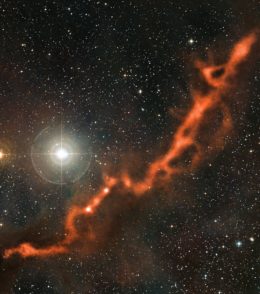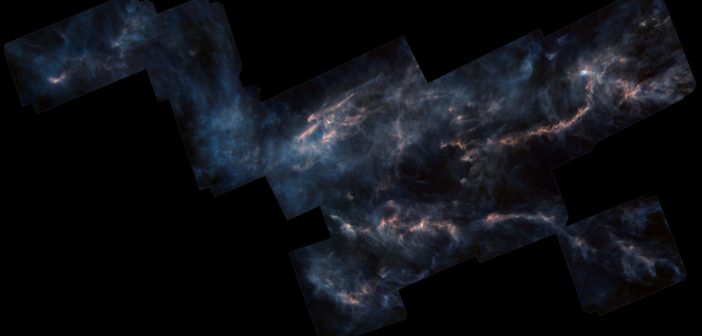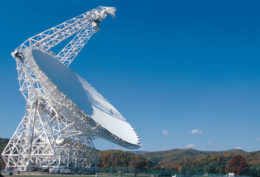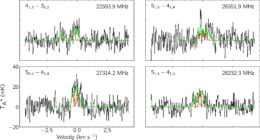What as-yet unidentified molecules lurk in the dark clouds of our nearby universe? Answering this requires observation, experiment, and theory — and GOTHAM is on the case.
The Search for New Chemistry

Another view of the Taurus Molecular Cloud, captured here in millimeter wavelengths by the APEX telescope. [ESO]
To this end, a team of scientists is undertaking the GOTHAM project: a radio search of a cold, dark cloud located 450 light-years away called the Taurus Molecular Cloud 1 (TMC-1). This chilly cloud has not yet collapsed to form a star, providing us with an opportunity to identify new molecules that are able to form in a cold, pre-stellar environment.
Hiding in Slow Motion
But the hunt for molecules in a cold, dark cloud is challenging! We generally identify molecules by searching for their signature transition lines in ISM spectra. But in cold clouds, molecules aren’t moving much, which makes their spectral lines very narrow. This means that we need extremely high-spectral-resolution telescopes to be able to identify them. Fortunately, GOTHAM leverages the 100-meter Green Bank Telescope (GBT), which is up to the task!
In a new article led by Brett McGuire (MIT, NRAO, and Center for Astrophysics | Harvard & Smithsonian), a team of scientists details the GOTHAM project and its early science results. This is just one of six new articles that describe the first molecular detections by GOTHAM.An Attack from All Angles
How does a new molecular detection work? As an example, we can look at GOTHAM’s discovery of propargyl cyanide (HCCCH2CN) in TMC-1.
First, due to the GBT’s high spectral resolution, the team needed to produce new, fine-detail guides for the forest of spectral lines expected from propargyl cyanide. This required new laboratory measurements of the molecule.
Next, the team had to search for these lines in the GBT data. Propargyl cyanide has 3,700 transitions that fall within GOTHAM’s observing range, all contributing to the total flux seen for this molecule. Teasing out these signatures requires complex data analysis.Finally, after achieving a significant detection of the molecule, the team had to do a sanity check. They conducted simulations of TMC-1 using astrochemical codes and included different channels that could form and destroy propargyl cyanide. They then checked that the abundances they measured for this molecule matched expectations from the simulations.
More Discoveries Ahead
This multi-faceted process has already led to a number of new detections in addition to propargyl cyanide. The detections are announced across a set of six articles — including an additional ApJ Letters publication, in which Ci Xue (University of Virginia, Charlottesville) and collaborators detail the first astronomical detection of isocyanodiacetylene (HC4NC) and the implications for how this molecule and others like it form in the ISM.
What’s more, all of these new results still only make up 30% of the eventual data that will be collected for the GOTHAM project. There’s plenty more to look forward to in the future as we continue to expand our understanding of the chemistry of the universe around us.
Citation
“Early Science from GOTHAM: Project Overview, Methods, and the Detection of Interstellar Propargyl Cyanide (HCCCH2CN) in TMC-1,” Brett A. McGuire et al 2020 ApJL 900 L10. doi:10.3847/2041-8213/aba632
“Detection of Interstellar HC4NC and an Investigation of Isocyanopolyyne Chemistry under TMC-1 Conditions,” Ci Xue et al 2020 ApJL 900 L9. doi:10.3847/2041-8213/aba631



1 Comment
Pingback: From AAS NOVA: “New Molecules from GOTHAM” | sciencesprings